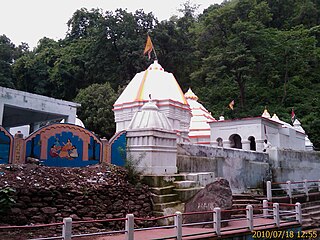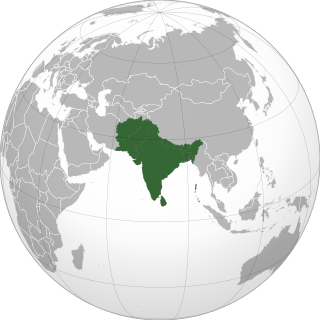Related Research Articles

Jagannatha is a deity worshipped in regional Hindu traditions in India as part of a triad along with his (Krishna's) brother Balabhadra, and sister, Subhadra. Jagannath, within Odia Hinduism, is the supreme god, Purushottama, and the Para Brahman. To most Vaishnava Hindus, particularly the Krishnaites, Jagannath is an abstract representation of Krishna, or Vishnu, sometimes as the avatar of Krishna or Vishnu. To some Shaiva and Shakta Hindus, he is a symmetry-filled tantric form of Bhairava, a fierce manifestation of Shiva associated with annihilation.
Kalinga is a historical region of India. It is generally defined as the eastern coastal region between the Ganges and the Godavari rivers, although its boundaries have fluctuated with the territory of its rulers. The core territory of Kalinga now encompasses all of Odisha and some part of northern Andhra Pradesh. At its widest extent, the Kalinga region also included parts of present-day Chhattisgarh, extending up to Amarkantak in the west. In the ancient period it extended until the bank of the Ganges river.

Balangir District, also called Bolangir District, is a district situated in Odisha state of India. The district has an area of 6,575 km2 (2,539 sq mi), and a population of 1,648,997. The town of Balangir is the district headquarters. The composition of the land is predominantly rural. Other important big & small towns in Balangir district are Titlagarh, Patnagarh, Kantabanji, Loisingha, Saintala, Belpada, Tushra, Agalpur, Deogaon, Chudapali, Biripali, Bhalumunda, Bangomunda, Sindhekela, Turekela and Muribahal.

Nuapada district is an area of Odisha state in India. Nuapada town is the headquarters of the district. It has one subdivision: Nuapada, and five blocks: Khariar, Sinapali, Boden, Komna, and Nuapada. Nuapada District has three Notified Area Councils: Khariar, Khariar Road, and Nuapada, six tehsils and more villages such as Gandabahali, Tukla, Hatibandha, Duajher, Bargaon, Tarbod, Udyanbandh, and Larka.

Dhenkanal State was one of the princely states of India during the period of the British Raj. The state is now referred to as Dhenkanal district, Odisha, with Dhenkanal town as its district headquarters.

Khariar is a city and a Notified Area Council in Nuapada District of the Indian state of Odisha.

The history of Odisha begins in the Lower Paleolithic era, as Acheulian tools dating to the period have been discovered in various places in the region. The early history of Odisha can be traced back to writings found in ancient texts like the Mahabharata, Maha Govinda Sutta and some Puranas. The region was also known to other kingdoms in region of East Indies due to maritime trade relations.

The Eastern Ganga dynasty were a large medieval era Indian royal Hindu dynasty that reigned from Kalinga from as early as the 5th century to the mid 20th century. Eastern Gangas ruled much of the modern region of Odisha in three different phases by the passage of time, known as Early Eastern Gangas (493–1077), Imperial Eastern Gangas (1077–1436) and Khemundi Gangas (1436–1947). They are known as "Eastern Gangas" to distinguish them from the Western Gangas who ruled over Karnataka. The territory ruled by the dynasty consisted of the whole of the modern-day Indian state of Odisha, as well as major parts of north Andhra Pradesh, parts of Chhattisgarh and some southern districts of West Bengal. Odia language got official status in their regime following the evolution of the language from Odra Prakrit. The early rulers of the dynasty ruled from Dantapuram; the capital was later moved to Kalinganagara, and ultimately to Kataka and then to Paralakhemundi.

Patna State was a princely state in the Eastern States Agency of India during the British Raj. It had its capital at Balangir. Its area was 6,503 km2 (2,511 sq mi).

Ananga Udaya Singh Deo, also known as A U Singh Deo is a politician from Odisha, India. He is elected to the Rajya Sabha in 2014 from Odisha.

Debakunda or Devkund is naturally created pond located in the Mayurbhanj district of Odisha, India, and is part of the Simlipal National Park. The flowing water from an adjacent waterfall has created this pond. There is a temple called "Ambika Mandira" that was discovered by Rajkumar Prafulla Chandra Bhanja Deo, a researcher and a king during British Raj who stayed at Devkund and researched about this place. Debakunda is home to lichen species like Parmeliaceae.
Nuapada is a Vidhan Sabha constituency of Nuapada district, Odisha.

Kalahandi State, also known as Karond State, was one of the princely states of India during the period of the British Raj. It was recognized as a state in 1874 and had its capital in Bhawanipatna. Its last ruler signed the accession to the Indian Union on 1 January 1948. The present titular head of the state is Anant Pratap Deo who resides in the Kalahandi Palace in Bhawanipatna

Bonai State was a princely state during the British Raj in what is today India. It was one of the Chota Nagpur States and had its capital at Bonaigarh, located in the present-day Sundergarh district of Odisha. It had an area of 8,907 square kilometres (3,439 sq mi) and a population of 24,026 in 1892 with an average revenue of Rs.60,000 in 1901.

The Bhanja dynasty is a dynasty that originated in the northern and central regions of modern Odisha before the Gupta Empire became an imperial power. The dynasty, of ancient local Kshatriya lineage as documented by Hermann Kulke, succeeded the Vindhyatabi branch of the Nagas of Padmavati, who ruled from the Keonjhar district of Odisha and included Satrubhanja of the Asanpat inscription. The Bhanj later became feudatories of the Bhauma-Kara dynasty.
Satrubhanja was a king who belonged to the Vindhyatabi branch of Nagavanshi rulers that ruled from Keonjhar district of Odisha in the early 4th century A.D. The era of Satrubhanja belongs to the pre Gupta rise as an imperial power in India when the other ruling Bharasiva Nagas of India joined hands to overthrow the ruling Devaputras of Pataliputra, also otherwise known as Kushan rulers to the modern historians. The Asanapat village dancing Nataraja Shiva inscription in Sanskrit Language with Post Brahmi or early Kalinga script of Satrubhanja provides a great deal of details about his achievements as a conqueror and spiritual man. The inscription is of thirteen lines which is written partly in verse and partly in prose.

Brahma Abadhuta Sri Guru Dayanidhi Paramahansa was an Indian sadguru, yogi, mystic and a Hindu spiritual leader well known in India. He was associated with the shakti school and viewed as a perfect spiritual master of gyan, yoga and prema or bhakti. His followers idealized him as their worshipped and beloved thakura (ठाकुर).
Yogimath is situated in Nuapada district at a distance of about 9 km from Khariar western Odisha border area and 67 km from Bhawanipatna of Kalahandi District. This place is famous for its neolithic cave paintings. In Yogimath caves the paintings are drawn by red paint over rock surfaces. The most significant pictures are of a bull followed by cow, calf and a man indicating the domestication of animal by man and agriculture. The past glory of this place is still unexplored. Near Yogimath, there is a mountain named Risipiti which is well known for producing clear echoes.

Gandabahali is a village in Sinapali Block in the south of Nuapada District in Odisha, India.
References
- ↑ Profile of JP Singh Deo http://www.navratnanews.com/Profile/profile_ofJitamitra%20Prasad%20Singh%20Deo.htm Archived 2 April 2012 at the Wayback Machine
- ↑ Pradhan, Sadasiba (2001). Rock art in Odisha. Aryan Books International. p. 16. ISBN 978-81-7305-215-6.
- ↑ Tripathy, Snigdha (1986). Early and medieval coins and currency system of Orissa, circa 300 B.C. to 1568 A.D. Punthi Pustak. p. 96. OCLC 15488618.